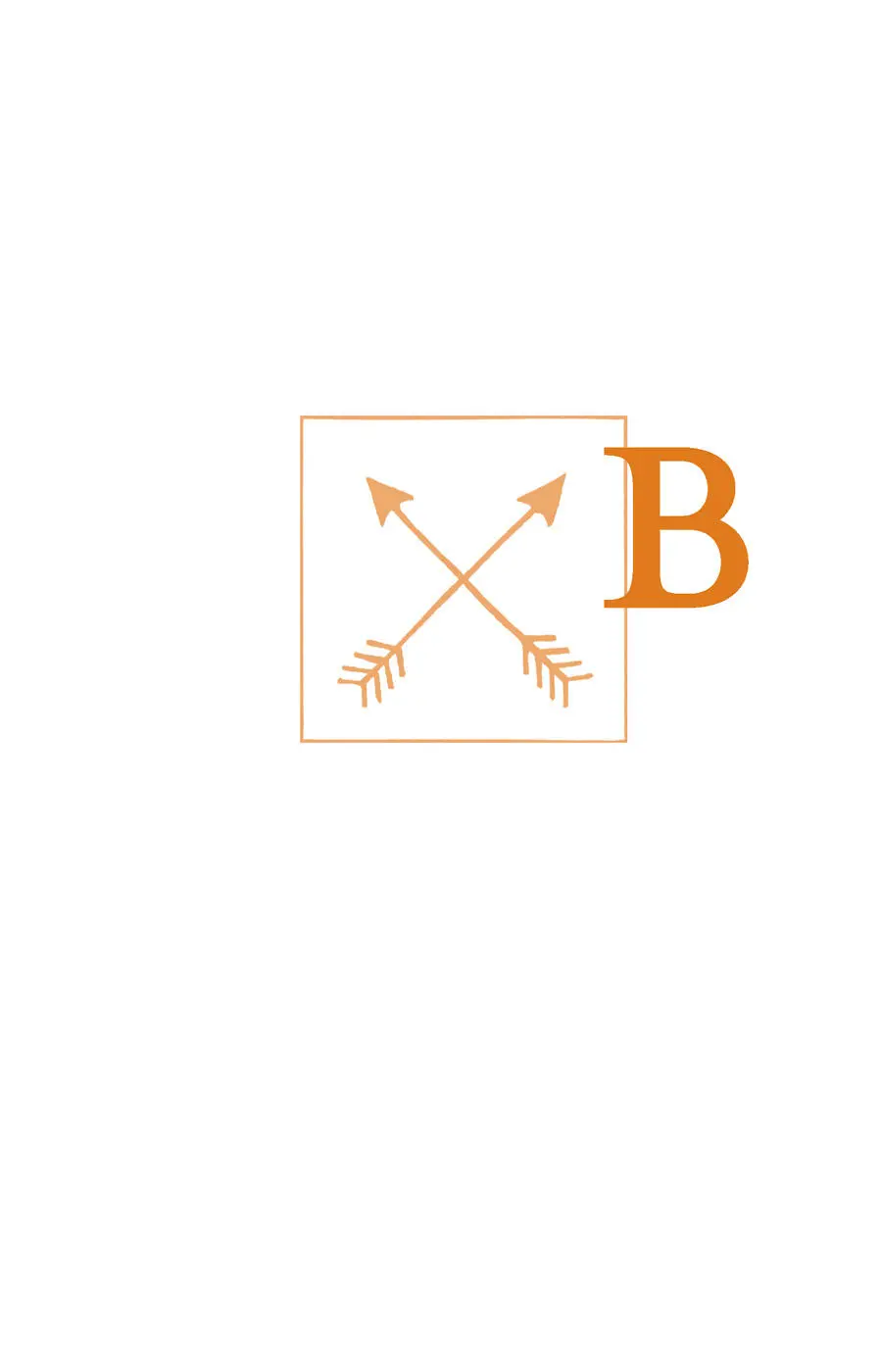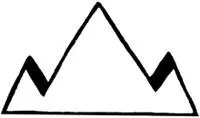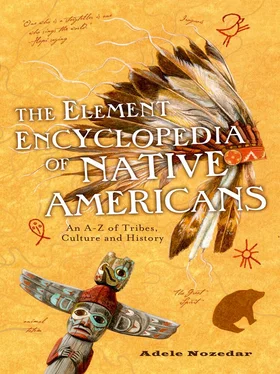Although Viking explorers reached America long before Columbus, it was Columbus’ “discovery” that really brought the continent to the attention of Europe and, consequently, to the rest of the world. And it was the Arawak with whom Columbus had the most contact.
A farming people, the Arawak had traveled to the Caribbean from South America, and called themselves the Taino, meaning “good people.” Able to grow a varied number of plants because of the tropical climate, the tribe supplemented these crops of corn, potatoes, cassava, peanuts, peppers, and tobaccowith hunting(mainly small game, specifically an animal called the Hutia ) and fishing (from dugouts; they speared fish and also caught sea turtles). The tribe built seaworthy dugout canoeswhich could take 100 people; these were used to carry goods to and fro between the Arawak and the Native peoples in South America.
The position of chief, or cacique, of each village, was a hereditary title; this could be a man or woman. Female chiefs were called cacicas . The chief lived in a square or rectangular house with a pitched roof; the villagers lived in circular huts and slept in hammocks, a Native American invention which has proved popular all over the world. These Arawak hammocks were the first that any European would have seen.
Because of the climate, little was needed in the way of clothing, and when Columbus encountered the Arawak he would have seen many naked natives. Both men and women wore beautiful jewelry made from natural materials that were ready to hand, such as shells or bone. The Arawak provided the first contact for many things as well as the hammock, which was rapidly copied as a way of sleeping on board ship. The amiable Arawak showed their visitors potatoes, corn, and, of course, tobacco; in fact, the Arawak word for “cigar” was tabaco .
The Arawak showed Columbus and his men nothing but kindness; this was not repaid. Columbus forced several members of the tribe to accompany him as slaves, and other potential colonists followed suit by treating the Arawak like slaves. The Arawak killed the Europeans, but when Columbus returned he tried to make the Arawak work for him in finding gold. This proved unsuccessful, but taking Natives to sell as slaves proved profitable.
The Arawak were among the first to suffer from the diseases brought by the Europeans, as well as dying of starvation when they were forced into slavery. Others killed themselves, unable to bear such subjugation.
A policy that was actively encouraged by the white settlers in order to encourage Native Americans to be absorbed into the “mainstream” culture. Assimilation of Natives into the ways of the white man generally resulted in the exchange of one culture for the other; for example, when they were sent to European schools, Native American children were not allowed to use their native tongue, and were encouraged to reject their traditional religious practices in favor of Christian ones. The movement toward assimilation was at its height in the late 1800s and the early 1900s.
Also known as the Rocky Mountain Sioux, despite the fact that the Assiniboin and the DakotaSioux share virtually the same language, the two were enemies for as long as anyone could remember. The early Jesuitsin America found the two peoples distinctly different from one another, except for their language.
The name Assiniboin means “one who cooks with hot stones,” and the tribe were given this name by the Ojibwe; the Assiniboin united with the Ojibwe, and also with the Creek, to fight the Dakota Sioux for overall control of the buffaloplains.
The Assiniboin originally lived in Canada, subsequently traveling south to what are now North Dakota and Montana. Sadly, many of the Assiniboin tribe fell prey to the white man’s disease of smallpoxin the 1840s and were wiped out.
A device used to make spear throwing more effective, the atlatl was a prehistoric invention. It was constructed from a stick approximately 2 feet long. Using a rock as a balance, there was a groove in the stick to hold the shaft of the spear in place, and loops made of animal hide with which the atlatl was grasped firmly.

This is the name given to a string, or thong, made from the hide of a caribou, a deer, or even an eel. A useful material, it was used in the same way that string or twine is used today, except it was likely to be much longer-lasting. Babiche would be made into skeins and carried around with a person just in case it was needed for repairs.
The Californian Native Americans made small boats from reeds or rushes that were tied together into bundles and bound into a cylindrical shape. After a period of use this small craft, or balsa , would become waterlogged and had to be dried out before it could be used again. The name “balsa” also refers to the lightweight wood that comes from the tree, whose Latin name is Ochroma pyramidale.

Smaller than a tribe, the term “band” is used to describe a small group of Native Americans, often a sub-division of a tribe or clan. A band might also be used to describe a group who had elected to follow a leader other than the accepted tribal chief.
A decoratively carved and polished stone or rock, often sculpted into the form of a bird. This might be mounted onto the top of a staff to show the authority of the bearer. Such decorative stones were also used as weights on the atlatl.
Related to the northern Paiutes, the Bannock belong to the northern Shoshonepeople.
Their original stamping ground included southeastern Oregon, southeastern Idaho, western Wyoming, and the southwestern part of Montana. They belong to the Paiute language group.
The Bannock had less trouble in general with the white settlers than other tribes. The tribe traded with other Indian nations, using their pottery, horn utensils, and salmon-skin bags as currency with which to barter. After they adopted the horsein the middle of the 18th century, they traded the animals with the Nez Perce.
The Bannock, as well as other tribes, place a huge amount of importance on the buffalo, not only for food but for all manner of essential items: clothes, implements, tipicoverings, etc. There was another natural resource that was an essential for the Bannock lifestyle: a plant named camas, a purple/blue flower whose bulb was an important form of nutrition, especially in the winter months when little else was available.
In 1868 the Bannock had been removed to the Fort Hall Reservationin Idaho. The rations allotted to them by the U.S. Government were not sufficient to keep the Indians from starvation. In the spring of 1871, the tribe left the reservation to harvest camas roots, but discovered that the settlers had allowed their livestock to roam free in the Great Camas Prairie; there were not enough of the precious tubers left. In addition, it became clear that the numbers of buffalo were rapidly diminishing due to dramatic overhunting by the white men. These two factors forced the Bannock to rebel against the white settlers and the U.S. Government, in an uprising known as the Bannock War, in 1878. The Bannock Chief, Buffalo Horn, made an allegiance with the northern Paiutes; the massed tribes made a series of raids on the white settlers in order to try to find some food. The tribes were defeated by the U.S. Army, and many members of the tribe were captured. After this defeat, they returned to the reservation at Fort Hall in southeastern Idaho.
Читать дальше














